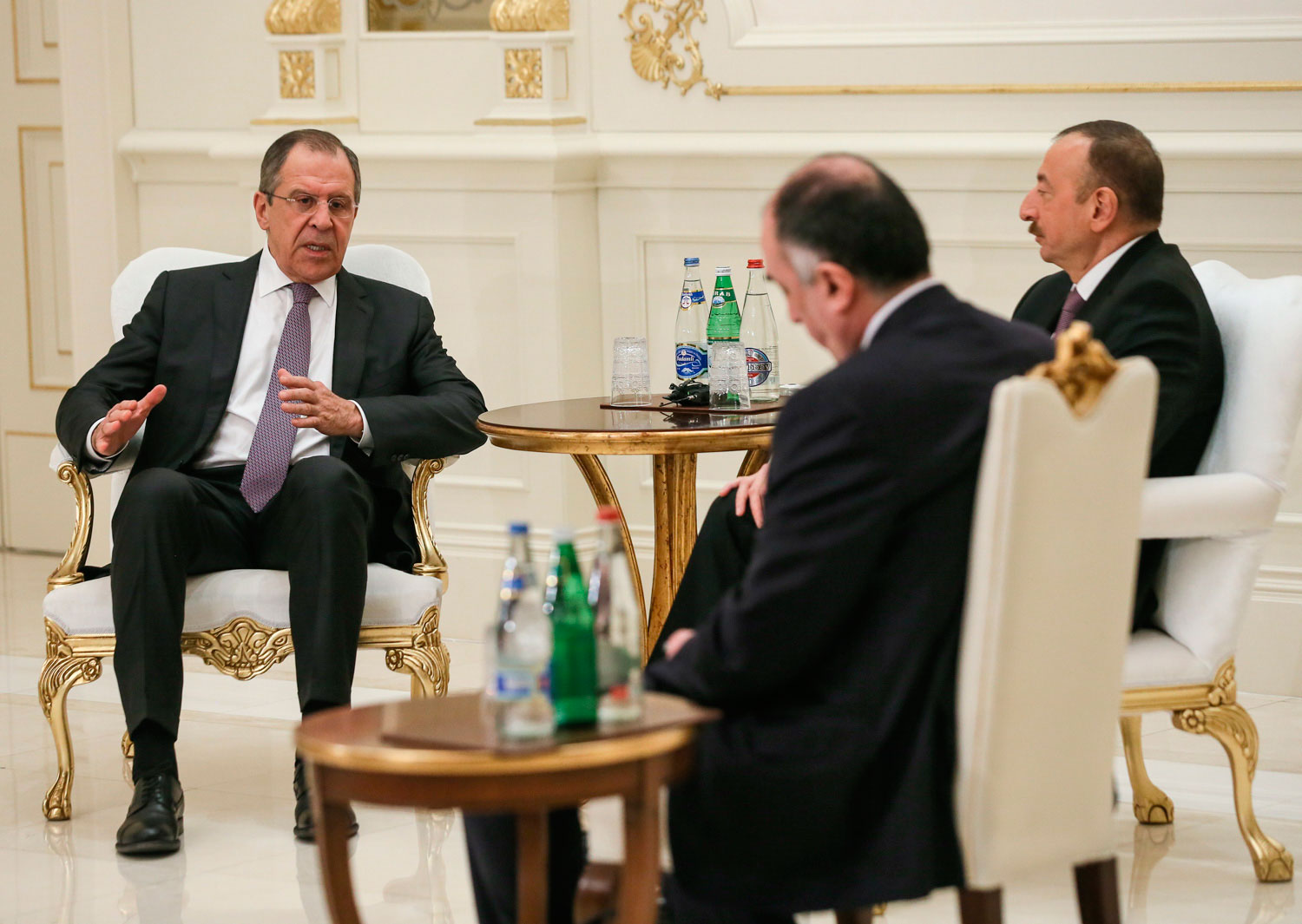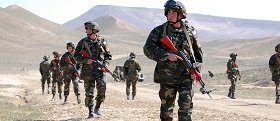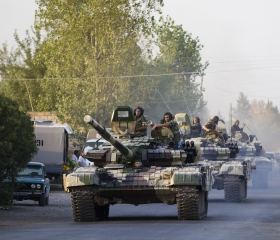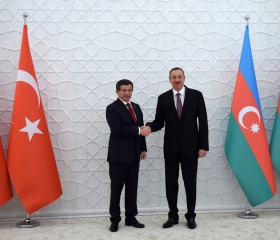The armed hostilities between breakaway Nagorno-Karabakh and her former parent-state Azerbaijan between April 2–5, 2016, or the Four Day War, as it will soon be labeled in the professional discourse, have now ended with a truce, agreed upon in Moscow between the Chiefs of the General Staff of Armenia and Azerbaijan, Yuri Khachaturov and Najmaddin Sadigov on April 5. The terms of ceasefire, supposedly, will become subject for longer-term deliberations among the diplomats of all sides engaged, spearheaded by the so-called Minsk Group of the Organization for Security and Cooperation in Europe, co-Chaired by Russia, France and the United States.
With neither peacekeepers, nor even robust mission of OSCE observers on the ground since the ceasefire agreement of May 1994, the hotspot may erupt again, as genie of nationalism is out of the bottle.
The armed hostilities allegedly began in the night of April 2, when both Serzh Sargsyan and Ilham Aliyev were in attendance of the Nuclear Security Summit in Washington DC. A day before, Sargsyan met with Vice-President Joe Biden and Aliyev had been in audience with Secretary Kerry. Both men discussed peace process in Nagorno-Karabakh, according to official reports. While Sargsyan asked Biden “to restrain” Azerbaijan and make it commit to peace process, Aliyev has got blessings for new and ambitious project of the Southern Gas Corridor, originating in Caspian shores of Azerbaijan.
Who did lighten up the powder keg, and why?
Speaking to Russian independent Dozhd (Rain) TV, the Azerbaijani Ambassador to Moscow Polad Bulbuloghli confirmed, that it was his country to initiate the armed hostilities, and “that will not seize until Armenian troops are on the ground”. He resorted to the common narrative in Baku about being “tired of” the ineffective peace process as the main rationale for the unprecedented offensive.
And Azerbaijan had many reasons for this escalation.
Looking into the military budget of Azerbaijan, where the government takes pride of having military expenditures “higher than the entire state budget of Armenia”, one will inevitably see that in 2015 Baku spent 165% more compared with 2006 (SIPRI), the year when Baku-Ceyhan oil pipeline became operational. The sharp decline in oil prices in the market, from 113USD per barrel for Azeri Light in June 2014 to just 31USD in January 2016, resulted in the total oil revenues of SOCAR shrinking manifold, around 11 times, according to expert estimates.
The ruling elite in Baku has also vastly utilized brinkmanship as the guiding principle in Nagorno-Karabakh issue for many years. Aliyev has masterfully been trying to trade in total oppression and jailing of opponents of his regime, other manifest abuses of human rights with the alleged importance that Azerbaijani hydrocarbons meant for European energy security. It has worked well for years, especially in the Council of Europe, and perhaps having fallen short of milking results he anticipated from the meeting in Foggy Bottom, Aliyev could have felt personally deceived and angry, thinking that pardoning many jailed activists on the eve of Washington visit bore no fruits. For years, there has been no targeted “naming and shaming” of parties derailing the peace talks, whether Armenia or Azerbaijan, while the mediators were trying to keep balance, that now quite ironically resulted in calculations that a military escalation would again not invite any sanction or punishment.
If so, a tiny war with visible gains could have strengthened his hand and make the White House urgently convene a Dayton-style meeting. But the blitzkrieg failed within few hours turning into a larger scale confrontation with the self-defense army of Nagorno-Karabakh – with tanks, artillery and missiles; and Aliyev had to depart from Washington.
This perfectly makes sense for those having monitored Aliyev’s behavior ahead of every single important meeting on Nagorno-Karabakh.
But he also had his domestic reasons to unleash the military adventure: the dire economic situation (he had to get loans from World Bank already), national currency depreciation to the 20-year low in December 2015, flagrant corruption scandals, cuts in oil income, numerous jailed activists, public protests and Western criticism could have altogether be resolved by redirecting public attention to the war effort, something that state propaganda has been cooking for years.
“Rally round the flag” effect, inherent in every ethnic conflict has been all around. In Azerbaijan – Mr Aliyev escaped public scrutiny after the leaked corruption scandal in Panama Papers. However, Mr Mammadyarov was not that successful – he was briefly grilled by CNN’s Becky Anderson on April 4.
In Armenia, so far involved only politically, Serzh Sargsyan emerged as an unquestionable leader who everyone else agreed to credit with a big load of legitimacy to take the nation out of the crisis. Even the radical opposition proposed to postpone the public discussions of the main agenda item – the Electoral Code – perhaps the first most important document after the Constitution has been adopted in referendum in December, 2015.
Apparently, all sides tried to use the international media to rally support for their respective positions. However most unexpectedly, the diplomats of self-declared Nagorno-Karabakh Republic emerged as legitimate representatives of their people from Washington DC to Paris, Moscow and Stepanakert, being interviewed in leading international media with full titles and affiliations, something that they were previously denied of.
To many, this raised hopes for a re-launch of peace process in its initial setting, with the participation of the Nagorno-Karabakh
Russia the dealmaker, and Turkey the dealbreaker
Some authors however suggest that Recep Tayyip Erdogan, the President of Turkey, whose eternal hug with Aliyev in Ankara weeks before had become a source of inspiration in social media, could have been behind encouraging Aliyev for the military escalation, too. Leaving aside conspiracy theories, main source of these judgments was the fact that only Turkey, among all other nations, voiced unequivocal support to Azerbaijani military adventure, to quote Erdogan, “till the end”.
True, on the other hand, Russia is thought by many to be the staunch ally of Armenia, based on the depth and spectrum of bilateral relations, including within the frameworks of CSTO and EAU. However, the Kremlin has made no statement of support to Armenia unilaterally, and from the early hours of escalation voiced only “concerns” – the key word in diplomatic glossary reiterated about the Four Day War worldwide.
After interventions from Russian Foreign Minister Sergei Lavrov, the Defense Minister Sergey Shoigu, Duma Speaker Sergei Naryshkin and then, in the afternoon of April 5, President Vladimir Putin himself, Nagorno-Karabakh and Azerbaijan agreed to cease fire and establish truce along the Line of Contact. As it would emerge on April 6, Chiefs of the General Staff of Armenia and Azerbaijan, Yuri Khachaturov and Najmaddin Sadigov, cut the verbal deal in Moscow to observe ceasefire beginning midday on April 5, which has held sustainably so far.
Although Russia’s role as the peacemaker in her own backyard became more evident once again, it should also be underlined, that the absence of official and unequivocal statements from Moscow in support of Armenia has been interpreted by many in Yerevan as a sign of decline in bilateral relations and only formal character of CSTO. The other two allies in EAU and CSTO – Belarus and Kazakhstan – spoke against Armenia, which even forced Armenian Foreign Ministry to summon Belarusian Ambassador for “a conversation”.
The ghost of UN Security Council Resolutions of 1993
The four resolutions, adopted by the UN Security Council back in April – November, 1993, have once again been referred to by the government in Baku as allegedly allowing the use of armed force against Armenians in Nagorno-Karabakh.
In a nutshell (so much as possible regarding UNSC Resolutions as such), throughout the time when the Security Council had the situation in and around Nagorno-Karabakh under its consideration, along with developments in the battlefield, the “withdrawal” of local Armenian troops outside NKAO was transformed from immediate requirement (S/Res/822) and unconditionality (S/Res/853) into a matter of “reciprocal and urgent steps” (S/Res/874), conditioned by establishing of a sustainable ceasefire and “removal of all obstacles to communications and transportation” (S/Res/874, para.5). The latest so far Resolution 884 demanded the “immediate cessation of armed hostilities and hostile acts” and “unilateral withdrawal” in one single line, thus keeping the issues of withdrawal and security of civilians equally significant to the lasting settlement. While Armenia and Nagorno-Karabakh responded positively on Res. 884 and assured commitment to abide, Azerbaijan never officially agreed to adhere, and continued hostilities up until the trilateral ceasefire agreement was mediated under the umbrella of OSCE Minsk Process.
International crimes during the war
Armenian President Serzh Sargsyan, speaking to his National Security Council on April 2, immediately after landing from Washington DC, and then to the OSCE Ambassadors in Yerevan on April 4, hinted at the common threat of recognizing the independence of Nagorno-Karabakh, this time under the banner of universally recognized doctrine of Responsibility to Protect. To remind, R2P doctrine has served as main narrative in South Ossetia, Libya, Crimea, Syria and many other hotspots.
The authorities of Nagorno-Karabakh leaked to the media, as well as transmitted to Yerevan and the International Committee of Red Cross graphic images of the family savaged in their own house in Talish village of Mardakert district by the Azerbaijani military units, as well as pictures showing results of indiscriminate artillery shelling of civilian areas well beyond the Line of Contact – amounting to war crimes.
Allegedly, according to both official press statements and video footage by journalists on the ground, at least in one instance a cluster bomb was fired onto the positions of Nagorno-Karabakh.
This, and other alleged violations of laws of armed conflict, may amount to erga omnes crimes (leave alone manifest violation of long-standing ceasefire agreement) under the relevant international treaties, and most prominently the Rome Statute of International Criminal Court. Although neither Armenia, nor Azerbaijan or Nagorno-Karabakh are members to ICC, referring the situation to the Court may become a necessary element in a future resolution package.
To re-launch the peace process
It will perhaps be premature to claim that the Four Day War left the parties in, what William Zartman would say, “a mutually hurting stalemate”, hungry to find a way out, but the international pressure will no doubt make the parties to return to negotiating table.
The Minsk Group co-Chair countries have for years toiled, despite criticism, to bring parties closer. Though occasionally met with bold criticism in Stepanakert and Yerevan, Baku has gone further in targeting the format and demanding the co-chairmanship to be amended to include it’s long-standing ally Turkey.
In the early hours of the military escalation, the mediators, one by one, made calls to urgently return to the peace process under the auspices of the Co-Chairmanship, boldly undermining all efforts to derail the present format. Both Russian Foreign Minister Lavrov (at press conference with Moldovan counterpart) and the spokesperson for U.S. State Department denounced “certain external players to instigate confrontation around [Nagorno] Karabakh”, hinting at involvement of Turkey.
So if the Minsk Process is to stay, the talks are likely to re-launch duly considering the realties on the ground.
The two principal elements to allow for a swift move forward are the twin questions of a more robust monitoring mission under the auspices of OSCE CiO Personal Representative and establishment of monitoring equipment along the LOC to open the Pandora’s box of ceasefire violation investigations mechanism. The OSCE shall exercise political will to strengthen the age-old mission Andrzej Kasprzyk with more and able personnel within the same mandate, adopted in 1995.
The return to full-scale negotiations, with the participation of Nagorno-Karabakh, will also fulfill the position that Azerbaijan held for some time: replacing the practically dead Madrid Document (to which Baku never fully consented to) with work on the Big Deal that will render a set of legally binding obligations upon all parties in the pursuit of comprehensive settlement, including the preparation of the future referendum at a defined timeframe.
Whereas both the armed forces of Nagorno-Karabakh and its diplomatic missions abroad reclaimed their importance and legitimacy in the eyes of international community, and with a view of getting to the comprehensive settlement, their “elected representatives” shall finally secure a place around the table, as provided in the CSCE Helsinki document of 1992 that launched the Minsk Process as such. Odds are that the leadership in Nagorno-Karabakh won’t accept any other precondition for ceasing fire in a conflict that they did not unleash, but managed to prevail in, again.








